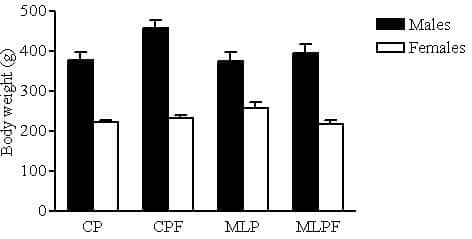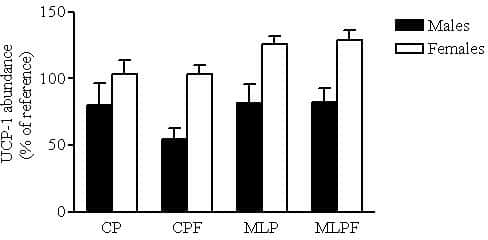Folic acid supplementation to the mother during pregnancy can prevent significant congenital malformations. However, the extent to which it can impact upon other metabolic processes is unknown. Previous studies, using a rat model, have demonstrated that consuming a maternal low protein (MLP) diet plus/minus folic acid supplementation has differential effects upon resting blood pressure (Torrens et al., 2006). However, the extent to which this diet may affect offspring adiposity after weaning is currently unknown. The present study, therefore, aimed to examine the effects of a MLP diet with/without a folate supplementation on interscapular (comprising of brown (BAT) and white (WAT)) fat mass and UCP-1 abundance in BAT. Fifteen virgin female Wistar rats (180-220g) were mated and randomly assigned to one of four feeding groups: control diet (CP: containing180g casein/kg, 1mg folic acid/kg; n=4), low protein (MLP: containing 90g casein/kg diet, 1mg folic acid/kg; n=3), control protein with folate supplementation (CPF: 180g casein/kg, 5mg folic acid/kg; n=4), or low protein with folate supplementation (MLPF: containing 90g casein/kg diet, 5mg folic acid/kg; n=4). All offspring were weaned at 21 days of age onto standard laboratory chow. One male and one female pup from each dam were culled at 13 weeks of age, and interscapular adipose tissue weight recorded. All procedures accorded with current UK legislation. Mitochondrial fractions were prepared from BAT and UCP-1 abundance determined. Results are given as means ± SEM and expressed as a percentage of a reference sample. Statistical differences (p<0.05) were determined using a General Linear Model test. Neither MLP nor folate supplementation affected offspring body weight at 13 weeks of age. However, females were lighter than males in all four diet groups (Figure 1; p<0.05) and possessed slightly more BAT relative to body weight (p=0.06) but only in the folate supplemented group. Folic acid supplementation significantly increased relative interscapular fat mass (CP: 2.6±0.3, CPF: 3.98±0.3, MLP: 2.43±0.3, MLPF: 3.31±0.2; p<0.01). UCP-1 abundance was significantly increased in female, but not male, offspring born to MLP dams (Figure 2; p<0.05). Furthermore, UCP-1 expression was increased in female offspring (p<0.001) irrespective of maternal diet. Despite an increase in relative interscapular fat mass in folate supplemented offspring, there is no corresponding effect upon UCP-1 expression suggesting that its WAT component may be increased. Consuming a MLP diet significantly increased UCP-1 abundance in females suggesting that sex steroids may be involved in the regulation of UCP-1 expression.Reference 1 : Torrens C, Brawley L, Anthony FW, Dance CS, Dunn R, Jackson AA, Poston L & Hanson MA (2006). Hypertension 47, 982-987.
University of Edinburgh (2007) Proc Physiol Soc 6, PC18
Poster Communications: Effect of maternal low protein and folic acid supplementation on interscapular fat mass and uncoupling protein (UCP)-1 expression in brown adipose tissue of resultant offspring.
F. Kamali1, M. A. Hyatt1, S. Engeham2, S. C. Langley-Evans2, M. E. Symonds1, H. Budge1
1. Centre for Reproduction and Early Life, Institute of Clinical Research, , University of Nottingham, Nottingham, United Kingdom. 2. School of Biosciences, University of Nottingham, Sutton Bonington, Loughborough, United Kingdom.
View other abstracts by:
Figure 1: Body weight at dissection (13 weeks)
Figure 2: UCP-1 expression in BAT at 13 weeks of age
Where applicable, experiments conform with Society ethical requirements.


